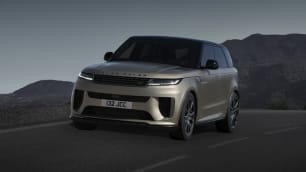Close your eyes and ask your eight-year-old self what an electric BMW SUV would look like, and chances are something like the iX will come to mind.
Sleek and slender, but still very BMW is the best way we can describe the iX.
Of course, we cannot talk about styling on a BMW without mentioning its front grille.
With a more vertically stacked orientation, the iX’s grille has been described as ‘toothy’ or even an ‘eye sore’ by the public in the past. But honestly, we think this attention-grabbing front end suits the swagger of the M60.
The gold highlights throughout are especially baller, and the grille serves as double-duty to hide a lot of the front-facing cameras and sensors required for more of the high-tech driving features like semi-autonomous driving.
The grille is flanked by BMW’s usual quad-headlight design for a menacing appearance on the road, and we particularly like the contrasting colours and sharp lines of our grey-coloured test car.
Another cool feature is the front badge, which can be popped up and serves as an inlet for the windscreen washer jets.
In profile, the 22-inch wheels look almost too small against the huge swathes of bodywork, but BMW has done a good job in slimming down the M60 thanks to the gloss-black stripe that runs along the bottom of the doors.
Speaking of, the handles might not pop-out like some of its rivals, but the recessed handle is highlighted nicely with gold-copper accents that also run along the beltline and door mirrors.
The D-pillar is also broken up with a blacked-out section that divides the roof, also helping slim down the behemoth BMW, and up close the section is embossed with ‘iX’.
At the rear, the clamshell boot might look large and bulky, but the design is helped by the very slender tail-lights and bumper broken up with more gloss-black.
Step inside the cabin, and the iX’s aesthetics are similarly unconventional, but the interior design also follows function.
For starters, the odd-shaped steering wheel is the feature that stands out the most, but you quickly realise the flat bottom helps with entry and exit into the driver’s seat.
As an all-electric model, there is no transmission tunnel, with the footwell between the driver and front passenger easily accessible for a more open-feeling cabin.
There is an armrest of course, while the area for multimedia controls is adorned with a one-piece, wood-like finish to contrast the crystal control knob. It’s a mix of technology and the natural environment, you see, much like the iX itself.
Do we love the styling of the iX M60? Much in the same way Louis Vuitton’s latest fashion range might not appeal to the masses, the iX M60 is likewise a polarising proposition.
To answer the question, yes, the iX M60 is a very stylish SUV that draws the eye and turns heads like nearly nothing else on the road – and that is exactly the point.

